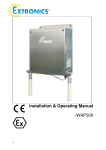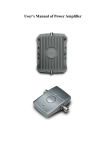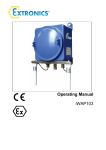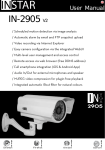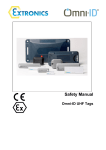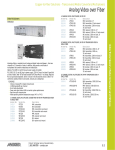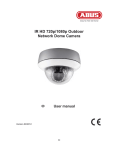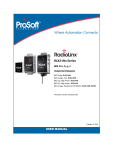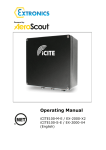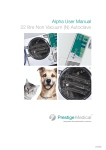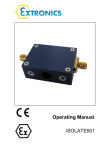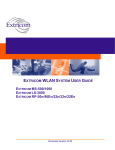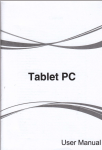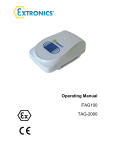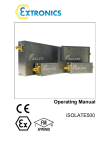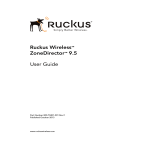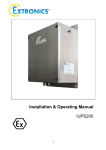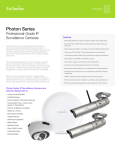Download Operating Manual
Transcript
Operating Manual iWAP105 Operating Manual This page is intentionally left blank. Document Number 325563 (See Last Page for Revision Details) ©2010 Extronics Limited. This document is Copyright Extronics limited. Extronics reserve the right to change this manual and its contents without notice, the latest version applies. 2 Operating Manual Contents 1 Introduction.......................................................................................................... 4 2 Safety Information and Notes .............................................................................. 5 3 2.1 Storage of this Manual ................................................................................. 5 2.2 List of Notes ................................................................................................. 5 Installation and Setting-to-Work .......................................................................... 7 3.1 4 Installation .................................................................................................... 7 3.1.1 Removing the cover .............................................................................. 7 3.1.2 Fitting the cables ................................................................................... 7 3.1.3 Line Power ............................................................................................ 9 3.1.4 POE/Ethernet Connection ................................................................... 10 3.1.5 Fibre Ethernet Input ............................................................................ 10 3.1.6 POE module Input............................................................................... 10 3.1.7 Earth Connection ................................................................................ 13 3.1.8 Thermostat Controls............................................................................ 13 3.1.9 Fitting the antennas............................................................................. 14 3.1.10 Setting to work .................................................................................... 14 3.1.11 Disassembly - Removing the PCB (For Information Only) .................. 15 3.1.12 Assembly – Fitting the PCB................................................................. 17 Intended Purpose Usage................................................................................... 18 4.1 Transportation and Storage........................................................................ 18 4.2 Authorized Persons .................................................................................... 18 4.3 Cleaning and Maintenance......................................................................... 18 4.4 Safety Precautions ..................................................................................... 19 4.5 Cleaning and Maintenance Intervals .......................................................... 19 4.6 Aggressive substances and environments ................................................. 19 4.7 Exposure to external stresses .................................................................... 19 5 Technical Data .................................................................................................. 20 6 FM Certificate .................................................................................................... 21 7 Manual Revision ................................................................................................ 23 3 Operating Manual 1 Introduction The iWAP105 Zone 1 Universal Access Point Enclosure is designed to allow the deployment of wireless networks in hazardous areas. The concept allows installation of equipment from leading WLAN vendors including Aeroscout, Meru, Symbol, Cisco and Firetide. Each type of Access Point or RF transmitting device is rigorously checked and tested by Extronics to ensure conformity. This means that the user may select the vendor of their choice when extending a WLAN to hazardous areas. However equipment not already certified will require assessment to determine its suitability. To allow ease of installation to the end user the unit can be supplied via a 110/230VAC, or via IEEE802.3af POE providing the access point chosen is compatible. An optional POE supply module allows the iWAP105 to power up to two external devices such as IP cameras or additional access points. The iWAP105 has four RF outputs on N-type connectors allowing the connection of two antennas for dual radio access points. These antennas must be FM certified. Optional features include surge arrestors for lightning suppression in outdoor installations and fibre optic inputs for the Ethernet. The iWAP105 has the option of adding heating to the enclosure which can be used when the access point is required to be installed in temperatures as low as -20 oC. The heaters may be independently configured to shut off above set temperature thresholds. The protection PCB has two potentiometers fitted, which allow the user to set the temperature at which the heaters will switch off, and the temperature above which power to the access point is switched on. The default setting is to allow the user to select a temperature of between 0 oC and 30oC above which the heaters are off, and temperatures between -20oC and 10oC above which the access point turns on. Note: These temperatures can be altered on request when ordering. . 4 Operating Manual 2 Safety Information and Notes 2.1 Storage of this Manual Keep this user manual safe and in the vicinity of the device. All persons who have to work on or with the device should be advised on where the manual is stored. 2.2 List of Notes The notes supplied in this chapter provide information on the following. • Danger / Warning. o Possible hazard to life or health. • Caution o Possible damage to property. • Important o Possible damage to enclosure, device or associated equipment. • Information o Notes on the optimum use of the device Warning Installation only to be performed by skilled electricians and instructed personnel in accordance with national legislation, including the relevant standards. Warning! Never open the enclosure in a hazardous area when the unit is energized, never operate the internal electronics without correctly fitting the lid and cable entry devices. Important The technical data indicated on the iWAP105 enclosure must be observed. Important Changes in the design and modifications to the equipment are not permitted. This includes changing the pre installed Access Point. Important The iWAP105 shall be operated as intended and only in undamaged condition. Important Only FM Certified antennas which have been approved for use by FM can be used with iWAP105 Important Do not exceed the Effective Isotropic Radiated Power (EIRP) limit for the country/region of operation 5 Operating Manual Important Do not exceed the Effective Isotropic Radiated Power (EIRP) for the gas group in which the iWAP105 will be operating. The RF output of the transceiver will vary depending on the hardware and antenna used. Groups A&B – 2W (+33dBm) Groups C – 3.5W (+35.4dBm) Group D – 6W (+37.7dBm) Caution This assembly may weigh up to 15Kg depending on requirements, therefore ensure the assembly is mounted using suitable fixtures. Caution When powering the iWAP105 via POE do not also apply AC power to the PCB. Important Ensure unused cable entries are fitted with the a certified stopping plug which meets FM standards, the stopping plug MUST be wrapped in PTFE thread sealing tape. Important protect the AC powered version of the iWAP105 with a 6 Amp circuit breaker or fuse 6 Operating Manual 3 Installation and Setting-to-Work 3.1 Installation The iWAP105 is simple to install and can be secured directly to a suitable surface using the mounting holes on the Enclosure. 3.1.1 Removing the cover Warning! Never open the enclosure in a hazardous area when the unit is energized, never operate the internal electronics without correctly fitting the lid and cable entry devices. Unscrew the grub screw and remove the enclosure lid by turning it anti-clockwise. Grub Screw Four Mounting Lugs, 1 in each corner Figure 3.1 3.1.2 Fitting the cables Depending on the configuration of the iWAP105, the connections for power and communication will need to be terminated into the enclosure, the cables are connected via conduit. Two sizes of entries are provided ¾” NPT and ½” NPT. IMPORTANT! Stopping boxes must be used on all cable entries, the stopping box must be installed within 18” of the enclosure. IMPORTANT! Ensure unused cable entries are fitted with the a certified stopping plug which meets FM standards, the stopping plug MUST be wrapped in PTFE thread sealing tape. IMPORTANT! Antennas can be installed in the four outer cable entries 7 Operating Manual Figure 3.2 Typical Cable Entry Layout Figure 3.3 – iWAP105 Internal PCB View 8 Operating Manual Important Ref 1 Only the input power connectors, Ethernet input connectors, thermostat controls and N-type/surge arrestors, as indicated in figure 3.3, are user configurable. Do not alter any other connections inside the enclosure. The access point must not be changed or the wiring altered. Connector Pinout Description Line power Input 1 2 Pin 1 = Live(Hot) Pin 2 = Earth Pin 3 = Neutral 3 Earth Screw Terminals 1 3 Ethernet input on RJ45 4 Ethernet input on screw terminals 2 1 8 Both screw terminals are connected to earth, one of the terminals should be used to earth the enclosure, the other connector is a spare This RJ45 socket accepts a standard 8P8C plug for Ethernet connection Pin 1 = Tx + Pin 2 = Tx Pin 3 = Rx + Pin 4= POE in Pin 5= POE in Pin 6= Rx Pin 7 = POE + Pin 8 = POE in + Pin 1 = Tx + Pin 2 = Tx Pin 3 = Rx + Pin 4= POE in Pin 5= POE in Pin 6= Rx Pin 7 = POE + Pin 8 = POE in + Table 3.1 – Input Connector Pin Outs Power can be supplied to the access point via a line power supply or a POE supply. The POE supply is obtained directly from a POE enabled Ethernet input with the spare wires of an 8 pin input used for the power supply. Caution 3.1.3 When powering the iWAP105 via POE it is not recommended to also apply an external power supply to the protection PCB. Line Power To connect the line power, feed the cable through a suitable cable entry device. The PCB will be shipped with a socket fixed to the PCB and a removable plug with screw terminals screwed into it (Ref 1). Remove the plug from the socket by unscrewing the screws at the two ends of the plug. Strip back the power cable and ensure suitable crimps are used for each core of the cable; the cables core must have a cross sectional area of at least 0.25mm2 and a maximum cross sectional area of 2.5mm2. Place the crimped wire into the correct screw terminal as indicated in table 3.1, and ensure the cable is securely screwed in place, then push the plug into the socket and securely screw the two together. 9 Operating Manual 3.1.4 POE/Ethernet Connection Caution Only make one Ethernet/POE connection, i.e. do not make a connection to both the screw terminals and RJ45 connector! To power the unit via POE a suitable POE supply is needed along with the Ethernet input on (preferably) a cat-5 cable. The power is supplied on the spare pins of a standard 8-way twisted pair wire - on pins 4,5,7 and 8, with the other pins used for data transfer. The power can be supplied via the screw terminals (Ref 4) or the RJ45 connector (Ref 3) depending on the installer’s requirements and preferences. To power the access point via POE using the RJ45 connector (Ref 3) ensure that an 8P8C connector is wired as stated in table 3.1. Feed the cable through a suitable cable gland and then simply plug the cable into the socket and ensure the cable is securely fastened. To power the access point via POE using the screw terminals (Ref 4), feed the cable through a suitable cable entry device. Remove the plug from the socket by unscrewing the screws at the two ends of the plug. Strip back the cable and ensure suitable crimps are used for each core of the cable; the cables core must have a cross sectional area of at least 0.14mm2 and a maximum cross sectional area of 1.5mm2. Place the crimped wire into the correct screw terminal as indicated in table 3.1, and ensure the cable is securely screwed in place, then push the plug into the socket and securely screw the two together. 3.1.5 Fibre Ethernet Input Important When connecting the access point via a fibre connection do not use the any of two Ethernet inputs of connectors Ref 3 or Ref 4. To obtain greater wired link distances the iWAP105 can be shipped with an optional fibre module. The fibre module will be connected directly to the access point, the user should attach the fibre cable directly to the fibre module using a multimode fibre cable on a ST connector. 3.1.6 POE module Input The POE module, if chosen, will be installed at the factory as an optional module; this should have been specified when ordering the iWAP105. The POE module cannot be installed on a pre-existing iWAP105 product. The Ethernet input to the iWAP105 will change from that described in the above sections if the POE module has been chosen. Instead of using the connections on the iWAP105 PCB, the Ethernet input is made directly to the POE module as described below. Important If the POE module has been fitted to the iWAP105 the Ethernet inputs on the main PCB (Ref 3 and Ref 2) will not pass data to the installed access point. The Ethernet input must made on the POE module as shown below 10 Operating Manual When the lid to the iWAP105 is removed the POE module can be seen on top of the main PCB. The POE module can have a few variations, each variation will look slightly different. Figure 3.4 below shows the POE module with a power supply fitted and a Fibre module fitted. This POE module can also be fitted with neither the power supply or Fibre module, or it could be fitted with either of the power supply or Fibre module. The actual configuration will depend on the requirements of each iWAP105. P6 S5 S4 S2 S1F S1 S3 S2F Fibre Module PFR PFT Power Supply 1 P1 1/9 8 P2 P3 P4 8/16 P5 Figure 3.4 – POE module Configuration 11 Operating Manual Table 3.2 below gives a description of each connector and switch’s function Reference P1 P2 P3 P4 P5 S1 S2 S3 S4 S5 S1F S2F PFR PFT Description Ethernet Input on RJ45 connector POE Output Port 1 on RJ45 connector POE Output Port 2 on RJ45 connector Ethernet Input on Screw Terminals POE Output on Screw Terminals Ports 1&2 Not user serviceable – should be set to 1:ON, 2-OFF Not user serviceable – should be set to 1:OFF, 2-OFF Reset Switch Not user serviceable – should be set to 1:OF, 2-OFF Not user serviceable – should be set to 1:ON, 2-ON Not user serviceable – should be set to 1:OFF, 2:OFF, 3:OFF, 4:OFF Not user serviceable – should be set to 1:OFF, 2:OFF, 3:OFF, 4:ON Fibre Receive Input Fibre Transmit Output Table 3.2 – POE Module Connections The access point installed on the iWAP105 PCB will automatically be connected to POE module, connecting to any of P1, P2, P3, P4, P5 or via the Fibre module will give the device connected connectivity to the access point. The Ethernet input should be made to P1 or P4 but not both. The POE outputs should be connected to either P2/P3 or P5 but not both. The top row of P5 is wired in parallel with P2, and the bottom row of P5 is wired in parallel with P3. The pins are distributed left to right from 1-8. To connect to the screw terminals on the POE module, feed the cable through a suitable cable gland. Remove the plug from the socket by unscrewing the screws at the two ends of the plug. Strip back the cable and ensure suitable crimps are used for each core of the cable; the cables core must have a cross sectional area of at least 0.14mm2 and a maximum cross sectional area of 1.5mm2. Place the crimped wire into the correct screw terminal and ensure the cable is securely screwed in place, then push the plug into the socket and securely screw the two together. An Ethernet connection is made on an 8 core wire, the list below details the pin out description of the POE modules screw terminals Pin 1 = Tx + Pin 2 = Tx Pin 3 = Rx + Pin 4 = spare / POE Pin 5 = spare / POE Pin 6 = Tx + Pin 7 = spare / POE + Pin 8 = spare / POE + 12 Operating Manual Caution Only make one Ethernet/POE connection, i.e. do not make a connection to both the screw terminals and RJ45 connector for each port simultaneously! P6 is used only if a fibre module is not used, this allows the extra port of the switch to be utilised if required Information The POE ports can also be used as standard Ethernet ports if required Important 3.1.7 Refer to your installation documentation to ensure the correct core of the cable used is connected to the correct pin of the screw terminal Earth Connection The earth screw terminals allow the user to connect the enclosure to earth, this would usually be done in the Extronics factory prior to shipping. There is also one spare earth terminal. To connect to this earth terminal strip back the cable and ensure suitable crimps are used; the cable’s core must have a cross sectional area of at least 0.25mm2 and a maximum cross sectional area of 2.5mm2. 3.1.8 Thermostat Controls Pot A Pot B Figure 3.6 – Thermostat Potentiometers If the optional heaters have been fitted, there are two potentiometers on the iWAP105 protection PCB which allow the user to alter the temperature set points. Pot A is used to set the access point switch on temperature, Pot B is used to control the heater turn off temperature 13 Operating Manual The potentiometers have a turn radius of 270o when the potentiometer is turned fully left the temperature will be set to a minimum. When the potentiometer is turned fully right the temperature is set to its maximum By turning potentiometer A fully left the Access point will not turn on until the temperature reaches -20oC. By turning Pot A fully right the AP will not turn on until the temperature reaches 10oC By turning potentiometer B fully left the heaters will not turn off until the temperature reaches 0oC. By turning potentiometer B fully right the heaters will not turn off until the temperature reaches 30oC. 3.1.9 • • • Fitting the antennas Fit the antennas as per the antenna manufactures instructions. Securely connect the antenna to the N-type or surge protector on the PCB. The iWAP105 may only be used with an antenna approved by FM.. IMPORTANT! Only connect antenna cables to the N-Type or Surge Arrestor. Never connect the antennas to the access point directly. Important Only FM Certified antennas which have been approved for use by FM can be used with iWAP105 IMPORTANT! Do not exceed the Effective Isotropic Radiated Power (EIRP) for the country/region of operation Important Do not exceed the Effective Isotropic Radiated Power (EIRP) for the gas group in which the iWAP105 will be operating. The RF output of the transceiver will vary depending on the hardware and antenna used. Groups A&B – 2W (+33dBm) Groups C – 3.5W (+35.4dBm) Group D – 6W (+37.7dBm) 3.1.10 Setting to work • • Once all cables are connected, Apply a small amount of silicon grease to the o-ring on the lid and refit by rotating clockwise, once the lid is closed ensure the grub screw is tightened. Refer to the original manufacturer’s instructions for detailed information on setting the hardware to work correctly in software. Note! Ensure the lid is secure, correct cable glands are fitted and the unit device correctly wired and earthed for the particular application Note! Ensure that the threaded sections of the enclosure lid and body assembly are clean and undamaged. Also check the IP O’ring is clean and undamaged before fitting the lid. 14 Operating Manual 3.1.11 Disassembly - Removing the PCB (For Information Only) Stage 1 Image Description Unscrew the enclosure lid. 2 Unscrew and disconnect the RF connectors from the surge arrestors or bulkheads. Unplug all other connections to the PCB. Make note of the location of the connections you remove to aid reassembly 15 Operating Manual 3 Unscrew the 4 fixing screws from the spacers below 4 Tilt the front of the PCB upwards and pull towards you. Be careful when removing the PCB from the enclosure as the RF cables fitted under the PCB may get damaged. Be sure to take all necessary ESD precautions to avoid damaging sensitive components on the PCB 5 Unscrew and disconnect the RF connectors from the surge arrestors or bulkheads on the under side of the PCB. Be careful not to bend the RF cables too tightly, especially by the connector, as this may damage the cable. Minimum bend radius of cable = 3.18mm 16 Operating Manual 3.1.12 Assembly – Fitting the PCB To fit the PCB, follow the instructions found in section 3.1.12 of this manual in reverse order; • Connect RF connectors to surge arrestors or bulkheads on under side of the PCB • Carefully place the PCB inside the enclosure to sit on top of the spacers • Screw the 4 fixing screws through the mounting holes on the PCB to the spacers below • Fit all necessary connections • Screw in the enclosure lid securely 17 Operating Manual 4 Intended Purpose Usage Important Before setting the units to work, read the technical documentation carefully. Important The latest version of the technical documentation or the corresponding technical supplements is valid in each case. The iWAP105 is built using modern components and is extremely reliable in operation; however it must only be used for its intended purpose. Please note that the intended purpose also includes compliance with the instructions issued by the manufacturer for installation, setting up and service. Any other use is regarded as conflicting with the intended purpose. The manufacturer is not liable for any subsequent damage resulting from such inadmissible use. The user bears the sole risk in such cases. 4.1 Transportation and Storage All iWAP105 devices must be so transported and stored that they are not subjected to any excessive mechanical stresses. 4.2 Authorized Persons Only persons trained for the purpose are authorized to handle the iWAP105; they must be familiar with the unit and must be aware of the regulation and provisions required for explosion protection as well as the relevant accident prevention regulations. 4.3 Cleaning and Maintenance The iWAP105 and all its components require no maintenance. All work on the iWAP105 by personnel who are not expressly qualified for such activities will cause the FM approval and the guarantee to become void. 18 Operating Manual 4.4 Safety Precautions Important For the installation, maintenance and cleaning of the units, it is absolutely necessary to observe the applicable regulations and provisions concerned with explosion protection. 4.5 Cleaning and Maintenance Intervals The cleaning intervals depend on the environment where the system is installed. 4.6 Aggressive substances and environments The iWAP105 is not designed to come into contact with aggressive substances or environments, please be aware that additional protection may be required. 4.7 Exposure to external stresses The iWAP105 is not designed to be subjected to excessive stresses e.g. vibration, heat, impact. Additional protection is required to protect against these external stresses. The iWAP105 will require additional protection if it is installed in a location where it may be subjected to damage. 19 Operating Manual 5 Technical Data Certification Type FM US and Canada Class I Div 1 ABCD, Class II Div 1 EFG, Class III Power Supply Universal 90-264VAC or IEEE802.11af POE Maximum 155VA 6A Circuit breaker recommended Enclosure Material Copper free aluminium alloy LM25 Ingress Protection Type 4/4X Weight Approx 15Kg, hardware dependent Dimensions 310 x 285 x 270 mm (w x h x d) Environmental Ambient temperature (T5/T6); -20ºC/-10ºC to 40ºC/55ºC (note this depends on the internal hardware used) Input Connections 10/100BaseT Ethernet on RJ45 socket and screw terminals 115V/230VAC input option on screw terminals Multimode fibre input option on ST connectors Note that connectors may be specified as an option in the ordering data Output Connections Up to four N-Type RF outputs on internal PCB or with optional lightning arrestors. Antennas To be used with up to four FM certified antennas (not included) 20 Operating Manual 6 FM Certificate 21 Operating Manual 22 Operating Manual 7 Manual Revision Revision 01 02 03 04 05 06 Description Initial Release FM Revisions Added Grease Removed RS232/RS485 Removed Ex Comments from Manual Changed front page picture, added FM certificate, and added specification. Cleaned the layout 23 Date 22/06/09 30/09/09 10/12/09 06/10/10 06/10/10 07/12/10 By NS NS NS NS NS AR























